
Flash Gordon & the Warriors of Mongo is a science fiction role-playing game published by Fantasy Games Unlimited in 1977 that is based on the Flash Gordon franchise. It was the first role-playing game to be based on a pre-existing media property.

Flash Gordon & the Warriors of Mongo is a science fiction role-playing game published by Fantasy Games Unlimited in 1977 that is based on the Flash Gordon franchise. It was the first role-playing game to be based on a pre-existing media property.
Flash Gordon & the Warriors of Mongo is a science-fantasy system based on the Flash Gordon comic series. [1] The game uses a "schematic" rules system in which characters and play are defined in only the most general of terms. [1] The game includes campaign setting material describing the realms of the planet Mongo. [1]
To create a character, the players roll dice to determine four characteristics, and based on those, they choose one of three character classes: warrior, leader, or scientist. [2] Unlike other role-playing games, the characters do not have hit points. Wounds are resolved on a case by case basis according to the situation. [2]
The storyline and setting in Flash Gordon are both largely predetermined, since the game is dedicated to producing the "feel" of a Flash Gordon short story or film serial. Unlike the open-ended campaigns of Dungeons & Dragons that can go on for an indeterminate time, this game ends when a clear victory condition is achieved. [2] As Jon Peterson noted in The Elusive Shift: How Role-Playing Games Forged Their Identity, "Just as it was possible for a premade setting to relieve a referee of the responsibility for inventing a world, so too could a design lift the burden of steering the narrative out of the referee's hand. The starkest example is Flash Gordon and the Warriors of Mongo (1977). Although the game takes place on the world of Mongo, the purpose of the system is no longer to simulate a world but instead to simulate a particular type of story." [2]
Scott Bizar formed FGU in 1975 to publish wargames, but as Dungeons & Dragons suddenly rose in popularity, Bizar turned to role-playing games. One of his first publications was 1977's Flash Gordon & the Warriors of Mongo, a licensed role-playing game based on the Flash Gordon franchise that he designed with science-fiction/fantasy author Lin Carter. The end result was a 52-page book, with cardstock reference card, that featured interior art by Alex Raymond, and cover art by Gray Morrow. [1] It was the first role-playing game that was based solely on a pre-existing media property. [2]
Ken St. Andre, the creator of Tunnels & Trolls , noted the "enormous potential" of this game, but added, "Unfortunately you will have to do most of the imaginative work yourself, as only the barest skeleton outline of various situations is described in the book." [3]
Jon Peterson commented, "Not only is the Flash Gordon system built around a specific world, but the design itself scopes play to a specific type of story in the world: one where the characters aspire to defeat Ming. That is simply a premise for the game that all players must accept." Peterson went on to say, "Flash Gordon furnishes an early example in which the referee's creative contributions to a role-playing game is unrelated to building a world or even determining the flow of events." [2]
A copy of Flash Gordon & the Warriors of Mongo is held in the collection of the Strong National Museum of Play (object 110.2923). [4]

Dungeons & Dragons is a fantasy tabletop role-playing game (TTRPG) originally created and designed by Gary Gygax and Dave Arneson. The game was first published in 1974 by Tactical Studies Rules (TSR). It has been published by Wizards of the Coast, later a subsidiary of Hasbro, since 1997. The game was derived from miniature wargames, with a variation of the 1971 game Chainmail serving as the initial rule system. D&D's publication is commonly recognized as the beginning of modern role-playing games and the role-playing game industry, which also deeply influenced video games, especially the role-playing video game genre.

Fantasy Games Unlimited (FGU) is a publishing house for tabletop and role-playing games. The company has no in-house design teams and relies on submitted material from outside talent.

A gamemaster is a person who acts as a facilitator, organizer, officiant regarding rules, arbitrator, and moderator for a multiplayer role-playing game. The act performed by a gamemaster is sometimes referred to as "gamemastering" or simply "GM-ing."
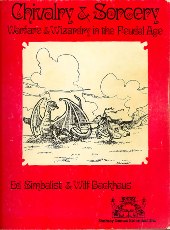
Chivalry & Sorcery is a fantasy role-playing game (FRP) first published in 1977 by Fantasy Games Unlimited. Created by Edward E. Simbalist and Wilf K. Backhaus in 1977, Chivalry & Sorcery (C&S) was an early competitor to Dungeons & Dragons (D&D). The designers of the game were dissatisfied with the lack of realism in D&D and created a gaming system derived from it, named Chevalier. They intended to present it to Gary Gygax at Gen Con in 1977 but changed their minds once at Gen Con once they met Scott Bizar who wrote out a letter of intent. After some changes eliminated the last remnants of D&D, Simbalist and Backhaus published the first edition of their game, now renamed Chivalry & Sorcery.
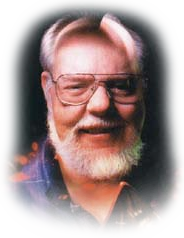
David Lance Arneson was an American game designer best known for co-developing the first published role-playing game (RPG), Dungeons & Dragons, with Gary Gygax, in the early 1970s. Arneson's early work was fundamental to the role-playing game (RPG) genre, pioneering devices now considered to be archetypical, such as cooperative play to develop a storyline instead of individual competitive play to "win" and adventuring in dungeon, town, and wilderness settings as presented by a neutral judge who doubles as the voice and consciousness of all characters aside from the player characters.

Blackmoor is a fantasy role-playing game campaign setting generally associated with the game Dungeons & Dragons. It originated in the early 1970s as the personal setting of Dave Arneson, the co-creator of Dungeons & Dragons, as an early testing ground for what would become D&D.

A campaign setting is a setting for a tabletop role-playing game or wargame campaign. Most campaign settings are fictional worlds; however, some are historical or contemporary real-world locations. A campaign is a series of individual adventures, and a campaign setting is the world in which such adventures and campaigns take place. A campaign setting is typically designed for a specific game or a specific genre of game, though some come from existing media. There are numerous campaign settings available for purchase both in print and online. In addition, many game masters create their own, which are often called "homebrew" settings.

Eberron Campaign Setting is a hardcover accessory for the 3.5 edition of the Dungeons & Dragons fantasy role-playing game.

Castles & Crusades (C&C) is a fantasy role-playing game published in 2004 by Troll Lord Games that is based on a simplified variant of the d20 System created by Wizards of the Coast. The game system is designed to emulate the play style of earlier editions of the Dungeons & Dragons game while keeping the unified mechanics of the d20 System. It has been credited with birthing the Old School Revival (OSR) in fantasy role-playing.
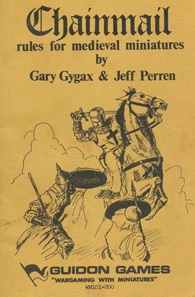
Chainmail is a medieval miniature wargame created by Gary Gygax and Jeff Perren. Gygax developed the core medieval system of the game by expanding on rules authored by his fellow Lake Geneva Tactical Studies Association (LGTSA) member Jeff Perren, a hobby-shop owner with whom he had become friendly. Guidon Games released the first edition of Chainmail in 1971.

Empire of the Petal Throne is a fantasy role-playing game designed by M. A. R. Barker, based on his Tékumel fictional universe. It was self-published in 1974, then published by TSR, Inc. in 1975. It was one of the first tabletop role-playing games, along with Dungeons & Dragons, and was the first published RPG game setting. Over the subsequent thirty years, several new games were published based on the Tékumel setting; however, to date, none have met with commercial success. While published as fantasy, the game is sometimes classified as science fantasy or, debatably, as science fiction.

The history of role-playing games began when disparate traditions of historical reenactment, improvisational theatre, and parlour games combined with the rulesets of fantasy wargames in the 1970s to give rise to tabletop role-playing games (TTRPGs). Multiple TTRPGs were produced between the 1970s and early 1990s. In the 1990s, TTRPGs faced a decline in popularity. Indie role-playing game design communities arose on the internet in the early 2000s and introduced new ideas. In the late 2010s and early 2020s, TTRPGs experienced renewed popularity due to videoconferencing, the rise of actual play, and online marketplaces.
The barbarian is a playable character class in the Dungeons & Dragons fantasy role-playing game. The class was introduced in 1985 and went through a number of variations in subsequent editions of the game.
David Wesely is an American wargamer, board game designer, and video game developer. Wesely's developments, inspired by Kriegsspiel wargames, were important and influential in the early history of role-playing games.

The original Dungeons & Dragons boxed set by Gary Gygax and Dave Arneson was published by Tactical Studies Rules in 1974. It included the original edition of the Dungeons & Dragons fantasy role-playing game. Its product designation was TSR 2002.
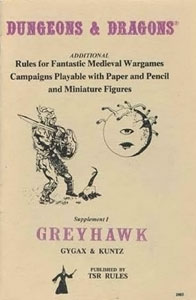
Greyhawk is a rules supplement written by Gary Gygax and Robert J. Kuntz and published for the original edition of the Dungeons & Dragons (D&D) fantasy role-playing game. It has been called "the first and most important supplement" to the original D&D rules. Although the name of the book was taken from the home campaign supervised by Gygax and Kuntz based on Gygax's imagined Castle Greyhawk and the lands surrounding it, Greyhawk did not give any details of the castle or the campaign world; instead, it explained the rules that Gygax and Kuntz used in their home campaign, and introduced a number of character classes, spells, concepts and monsters used in all subsequent editions of D&D.

A tabletop role-playing game, also known as a pen-and-paper role-playing game, is a kind of role-playing game (RPG) in which the participants describe their characters' actions through speech and sometimes movements. Participants determine the actions of their characters based on their characterization, and the actions succeed or fail according to a set formal system of rules and guidelines, usually involving randomization. Within the rules, players have the freedom to improvise, and their choices shape the direction and outcome of the game.
Braunstein is an experimental game and game genre introduced by David Wesely, a member of the Midwest Military Simulation Association, in the late 1960s, and originally played in the Twin Cities. Braunstein was important and influential in the early history of role-playing games.

Adventures in Fantasy is a role-playing game published by Excalibre Games in 1979, designed by Dave Arneson and Richard Snider. The game is a fantasy system, similar to early Dungeons & Dragons (D&D), which Arneson co-created. It received mixed to negative reviews in game periodicals, including The Space Gamer, Ares, and Pegasus, and ultimately flopped. Arneson later bought the rights to Adventures in Fantasy and published a new edition in 1981 through his own company Adventure Games.
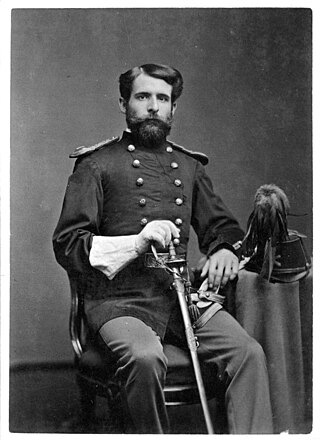
Strategos is a military wargame developed by Charles A. L. Totten for the United States Army, and published in 1880.